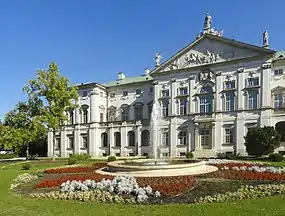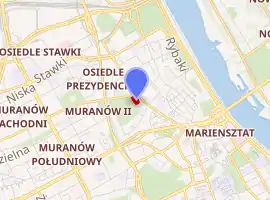Krasiński Palace
The Krasiński Palace (Polish: Pałac Krasińskich), also known as the Palace of the Commonwealth, is a reconstructed Baroque palace in Warsaw, Poland, on Krasiński Square (Plac Krasińskich). Initially erected between 1677 and 1683 for the powerful Krasiński family, it was heavily damaged during World War II and rebuilt in the mid-20th century.
| Krasiński Palace Pałac Krasińskich | |
|---|---|
 Krasiński Palace, view from the gardens | |

| |
| General information | |
| Architectural style | Baroque |
| Town or city | Warsaw |
| Country | Poland |
| Construction started | 1677 |
| Completed | 1683 |
| Demolished | 1944 |
| Client | Jan Dobrogost Krasiński |
| Design and construction | |
| Architect | Tylman van Gameren |
History and architecture
_02.jpg.webp)
The palace was built in 1677–83 for the Voivode of Płock, Jan Dobrogost Krasiński, according to design by Tylman van Gameren. It was decorated with pediment reliefs showing the triumph of the legendary "ancestor" of the Ślepowron and Korwin Polish clans, the Roman commander Manius Valerius Maximus Corvinus Messalla (263 BC) and sculptural work, all by Andreas Schlüter.[1]
Jan Dobrogost Krasiński, who also served as the royal clerk (Referendarz), was a descendant of old Mazovian nobility and an heir to a large fortune. After his father's death he wished to erect a magnificent residence in the capital which was to fulfill his excessive political ambitions and show his enormous pride, which made him cultivate and develop a 16th-century legend about the antique origin and alleged royal connections of his family.
Krasiński was well acquainted with French culture and architecture; he was interested in hiring qualified and renowned French artists and architects that would perform the work. He kept a detailed accountancy book in which he systematically recorded progress in construction. The whole idea was realized according to the design of Tylman van Gameren. He was of Dutch origin, educated in Italy, and he was brought to Poland by the Lubomirski family. He made a large number of various designs for Lubomirskis, the Royal Family, the representatives of different noblemen and gentry families as well as for the Catholic Church. Some Warsaw architects were also employed to build the palace as building contractors, as suppliers of materials or to control the master craftsmen, bricklayers or artisans. These people were Joseph Bellotti, Jacob Solari, Izydor Affaita and Maderni. The main role in decorating the palace was played by German sculptor, Andreas Schlüter, who had previously cooperated with Tylman.
The first floor porte-fenêtre (vertical French door and window) was crowned with a cartouche supported by two angels bearing the founder's monogram JK for Jan Krasiński. The frescoes were made by John III Sobieski's court painter Michelangelo Palloni.[1] Among his notable works in the palace, most worth mentioning are the plafond and frescoes in the supraportes (the space between the portal and ceiling) of the palace's vestibule. Moulding which remain in vestibule and partly in the stairwell, also the heads of pilasters or festoons on external elevations made of stucco as well as the armorial cartouche of the façade from the garden side were made by unknown artists under the supervision of Joseph Belloti. The lost paintings in the vestibule destroyed during World War II were painted by Michael Palloni. The interiors were partially finished by 1699. Other paintings by Albrecht Dürer, Antonio da Correggio, Rembrandt and Peter Paul Rubens are no longer present.[2]
The palace-garden complex was created on a vast property between Długa and Świętojerska Streets, in the place of the old manor house with small garden that belonged to Krasiński. Krasiński purchased some surrounding plots to extend the gardens. According to Gameren's conception, the palace was intended as a French style palace entre cour et jardin (between the entrance court and the garden) with cour d'honneur, two symmetrical outbuildings, parterre garden (à la française) with three radial alleys and a palace in the center of the axis, but it was never fully accomplished.
In 1765 the palace was purchased by the Rzeczpospolita (Commonwealth; the Polish State) and became the seat of the Treasury Commission. After a fire in 1783 it was remodelled according to Domenico Merlini's design.[1] During the interwar period, the palace housed the Supreme Court of Poland.
The palace was burned down and partially demolished by the Germans during World War II, with the outer shell remaining mostly intact.[3][4] Today it is a part of the Polish National Library's Special Collections Section (socializing in manuscripts and old prints) from the Załuski Library (only 5% of the former collection remains in the palace, the rest was deliberately destroyed by the Germans after the collapse of the Warsaw Uprising in October 1944).[5][6]
Images
 Krasinski Square, 1890s
Krasinski Square, 1890s The Palace in 1939
The Palace in 1939.jpg.webp) Soon after World War II
Soon after World War II
 Pediment: Triumph of Marcus Valerius Corvinus by Andreas Schlüter
Pediment: Triumph of Marcus Valerius Corvinus by Andreas Schlüter Krasiński Garden
Krasiński Garden
See also
- Field Cathedral of the Polish Army
- Załuski Library
- Czapski Palace - Warsaw's other palace that is sometimes called "Krasiński Palace"
References
- Stefan Kieniewicz, ed. (1984). Warszawa w latach 1526-1795 (Warsaw in 1526-1795) (in Polish). Warsaw. ISBN 83-01033-23-1.
- "Krasiński Palace". eGuide / Treasures of Warsaw on-line. Retrieved 2008-09-22.
- Krystyna Kreyser. "Pałac Krasińskich". www.gazetaecho.pl (in Polish). "Puls Warszawy" No. 10. Archived from the original on 2007-11-28. Retrieved 2009-03-29.
- "Plac Krasińskich i ulica Długa". www.warsawtour.pl (in Polish). August 1998. Retrieved 2009-03-23.
- Wanda M. Rudzińska, Straty w zbiorach Gabinetu Rycin Biblioteki Uniwersyteckiej w Warszawie w latach II wojny światowej "Archived copy". Archived from the original on 2006-02-14. Retrieved 2008-01-31.CS1 maint: archived copy as title (link)
- Tomasz Stańczyk (2 October 2004). "Blizny i relikty". Rzeczpospolita (in Polish) (232). Archived from the original on 12 June 2009. Retrieved 2009-03-23.
- Mossakowski, Stanisław (1972). Pałac Krasińskich. Warsaw: PWN.
- Mossakowski, Stanisław (2012). Tylman from Gameren. Kraków: DiG.
- The Encyclopedia of Warsaw. PWN. 1994.
- Putkowska, Jolanta (1991). The Architecture of Warsaw in XVII century. PWN.
- Miłobędzki, Adam (1980). The Polish Architecture in the XVII century. PWN.
External links
| Wikimedia Commons has media related to Krasiński Palace. |
- (in Polish) Sąd Najwyższy. Historical pictures of the palace.
- (in Polish) Pałac Krasińskich w Warszawie
